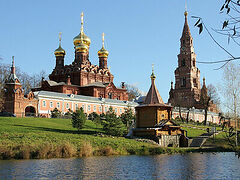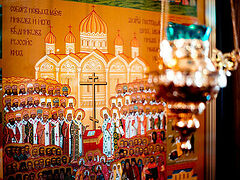 Igumen Ippolit (Yakovlev) One of the most colorful pages of the tragic twentieth century in the land of Radonezh was the so-called “Ippolit Case”, in which New Martyr Kronid (Lyubimov; 1859–1937; commemorated November 27/December 10), the last abbot of the Holy Trinity-St. Sergius Lavra before its closure in 1920, was arrested and sentenced to death. So, who was the mysterious Ippolit? Why did the authorities hate him so much that the case on charges of counter-revolutionary activities, the formation of a monarchist group, the preservation of an illegal monastery, the support of the Lavra monks (both exiled and imprisoned, and those who had returned) was named after him? Despite such a high-profile case, the name of Abbot Ippolit was never widely known, his spiritual labors for the most part remained a hidden mystery, but by God’s Providence a part of this mystery was revealed to us—for a candle cannot be hidden under a bushel (cf. Mt. 5:15). And today we would like to pay tribute to the elder, whose ascetic labor was revealed to us for our instruction and edification.
Igumen Ippolit (Yakovlev) One of the most colorful pages of the tragic twentieth century in the land of Radonezh was the so-called “Ippolit Case”, in which New Martyr Kronid (Lyubimov; 1859–1937; commemorated November 27/December 10), the last abbot of the Holy Trinity-St. Sergius Lavra before its closure in 1920, was arrested and sentenced to death. So, who was the mysterious Ippolit? Why did the authorities hate him so much that the case on charges of counter-revolutionary activities, the formation of a monarchist group, the preservation of an illegal monastery, the support of the Lavra monks (both exiled and imprisoned, and those who had returned) was named after him? Despite such a high-profile case, the name of Abbot Ippolit was never widely known, his spiritual labors for the most part remained a hidden mystery, but by God’s Providence a part of this mystery was revealed to us—for a candle cannot be hidden under a bushel (cf. Mt. 5:15). And today we would like to pay tribute to the elder, whose ascetic labor was revealed to us for our instruction and edification.
Abbot Ippolit (secular name: Ivan Stepanovich Yakovlev) was born on January 31, 1844 in the former city of Novogeorgievsk1, Kherson province to the family of a military worker. He was home-schooled. At the age of eighteen he came to the Holy Trinity-St. Sergius Lavra, where for about ten years he was an unofficial novice. In 1884, he received permission from the civil authorities to begin the monastic life, and joined the official novices of the Lavra. He was given the obedience of clerk in the office of the Lavra treasurer. On March 27, 1888, he was tonsured into the mantia at the Gethsemane Skete together with the future abbot of the Lavra and New Martyr Kronid (Lyubimov), with whom he would later be arrested in the same case. On September 25, 1890, Fr. Ippolit was ordained hierodeacon, and five years later, hieromonk. In 1895, Hieromonk Ippolit was appointed librarian of the Lavra. On September 29, 1897, the Lavra’s Spiritual Council appointed him one of the six full-time hieromonks who served at the St. Sergius’s reliquary.
From that time on, Fr. Ippolit began to be actively involved in charitable and missionary work. He provided significant assistance to specialized schools, gymnasiums and parochial schools. He became not only the organizer and benefactor, but also a trustee of the Annunciation School in the village of Blagoveshchenye near the Holy Trinity-St. Sergius Lavra, building a wooden house, providing it with everything necessary and rendering regular assistance. Fr. Ippolit was also for many years the Lavra’s authorized representative of the Imperial Orthodox Palestine Society.
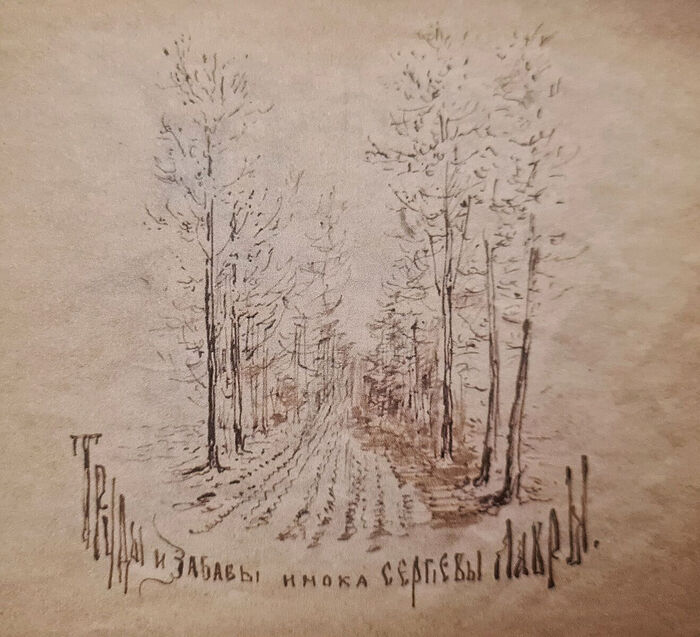 “Labors and amusements of a monk of the St. Sergius Lavra”
“Labors and amusements of a monk of the St. Sergius Lavra”
On February 13, 1901, on the recommendation of the Lavra’s deputy abbot, one more obedience was given to Fr. Ippolit:
“In view of the highly moral behavior of Hieromonk Ippolit and his sufficient erudition in Patristic writings…”, he was appointed caretaker of the Church of Sts. Zosima and Savvaty and the father-confessor of pilgrims in place of the reposed Igumen Arkady. Being a spiritual father became Fr. Ippolit’ main ministry for the rest of his life. In 1905, he was appointed the brethren’s father-confessor. “The Spiritual Council designates All Saints’ Church, below the Dormition Cathedral, as the place for the confessions of the brethren and pilgrims.”
Around this time Fr. Ippolit met Alexandra Vasilievna Vasilyeva, who became his spiritual daughter and left behind a small notebook with drawings, spiritual words, and short edifying poems by Fr. Ippolit. All the sayings were written in calligraphic handwriting and originally designed. These records reflect the elder’s love for his beloved Lavra and his monastic calling. The main themes of the sketches are a church or a chapel in a forest, a lone traveler, a road leading into the distance, a hut-cell with a hermit on the doorstep... “Labors and amusements of a monk of the St. Sergius Lavra”, as Fr. Ippolit himself called his drawings, they are still impressive today. Here you can see the elder’s many interesting sayings, expressed in a playful poetic style, but in essence very deep and instructive:
You and I live, the time will come and we will die.
And people all live, in the end they will die.
The first entry, “Peace be with you”, was made in 1906, and the last one, “The end of everything. A crown to those who lived decently and loved Christ”, is dated April 29, 1924. The sketches and notes made over the span of eighteen years convey to us the image of a meek, wise and loving elder-comforter, who wishes everyone salvation; not authoritarian, but considerate and tactful. But when necessary, batiushka could say a sharp word for edification. Fulfilling the obedience of father-confessor in the difficult pre-revolutionary times, he often encountered a lack of trust in God and His Providence, with excessive concern for earthly problems. In one of his sermons, he said:
“In these brief two hours you must forget everything earthly in order to truly prepare for that great and priceless sacrament for which you were preparing; and if you cannot stop your vain, sinful thoughts, then at least stop your words, over which you have power and for which you will answer before God...”.
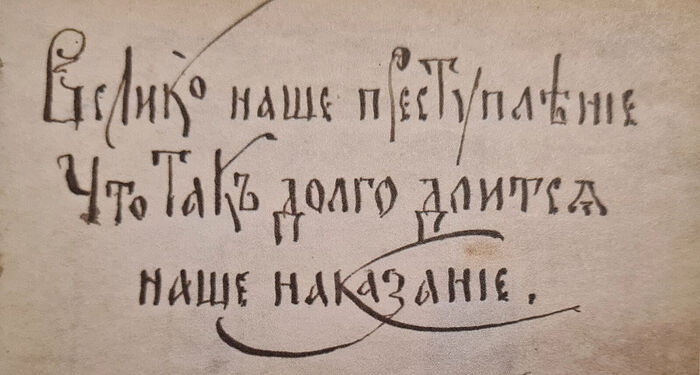 “Our crime is GREAT, and so our punishment is SO long.”
“Our crime is GREAT, and so our punishment is SO long.”
In 1914, Fr. Ippolit, at the request of the rector of the Academy, was appointed father-confessor of the students of the Moscow Theological Seminary and Academy. By 1917 he had become one of the highly esteemed elders of the Lavra. However, the thundercloud that enveloped Russia was already approaching the walls of the Holy Trinity-St. Sergius Monastery... On June 24, 1918, Fr. Ippolit wrote prophetic words to A.V. Vasilyeva: “Our crime is GREAT, and so our punishment is SO long.” Indeed, the punishment lasted decades...
On November 10, 1919, the Sergiyev2 Executive Committee adopted a resolution on the dissolution of the Holy Trinity-St. Sergius Lavra. On the night of November 3, 1919, a search was unexpectedly carried out in the monastery, and the brethren were expelled.
After the expulsion of the brethren from the Lavra, Fr. Ippolit lived for some time at the Chernigov Skete. From that time on, he took a new path—that of wandering. He stayed in different villages between Sergiyev Posad and Pushkino, often attending services at the Church of the Smolensk Icon in the village of Sofrino, where Abbot Platon (Klimov) served after 1930.
 Abbot Ippolit. Landscape. Watercolor, gouache, ink In Sergiyev Posad, Fr. Ippolit visited the house of Nun Euphrosyne (Baranova), at 76 Kirov Street. After the Lavra and its hermitages had been closed, many icons (including the wonderworking Chernigov Icon) were kept in this house, and the Liturgy was secretly celebrated. Monks expelled from the Lavra and persecuted priests passing through the town served here. Here the elder organized a small workshop, where he compiled an album of landscapes in a complex technique of watercolor and gouache, with the addition of pen and ink. On the title page of the album, in ink the elder depicted Golgotha.
Abbot Ippolit. Landscape. Watercolor, gouache, ink In Sergiyev Posad, Fr. Ippolit visited the house of Nun Euphrosyne (Baranova), at 76 Kirov Street. After the Lavra and its hermitages had been closed, many icons (including the wonderworking Chernigov Icon) were kept in this house, and the Liturgy was secretly celebrated. Monks expelled from the Lavra and persecuted priests passing through the town served here. Here the elder organized a small workshop, where he compiled an album of landscapes in a complex technique of watercolor and gouache, with the addition of pen and ink. On the title page of the album, in ink the elder depicted Golgotha.
In the difficult 1920s, Fr. Ippolit left written instruction for his spiritual children in just four words: “Be careful, watch, endure, and pray.”
In the final years of his life, already a much-venerated elder, he spoke little and behaved as a fool-for-Christ. At any time of the year he would walk down the street wearing only a cassock, and barefoot, so his legs often swelled and hurt. He slept on the floor or in a coffin.
There were two attempts to arrest Fr. Ippolit. The first one was in 1928 in the “Case of an Anti-Soviet Group of Black Hundred Elements3 in the Town of Sergiyev, the Moscow Region”. The elder was about eighty-four at the time. He replied to those who had come to arrest him: “Let me go and get dressed. I’m barefoot and undressed and may freeze. Wait here while I go and get dressed.” He went out, walked through the back door, and they couldn’t find him.
For the final ten years of his life the elder secretly lived in the house of Nikolai Mikhailovich Sychev at 5 Pravaya Shtatnaya Street. It accommodated a “house monastery” of the former Lavra brothers. In November 1937, the NKVD authorities opened a case against the Lavra Abbot, Archimandrite Kronid, along with N. M. Sychev, and many brothers and residents of his house. The indictment read:
“The ideological leaders of this counter-revolutionary group were the abbot of the former Holy Trinity-St. Sergius Lavra, who in the past enjoyed the special favor of the former royal Romanov House, the ardent monarchist Konstantin Petrovich Lyubimov, and the former Dean of Zagorsk4 and other regions, nobleman Archpriest Dimitry Fedorovich Bayanov. This counter-revolutionary monarchist group of monks and clergy maintained until recently the continuity of the Holy Trinity-St. Sergius Lavra as an illegal monastery, while maintaining its statutory order of relations between themselves and in relation to Archimandrite Kronid; the old, especially monastic order of church services was preserved, in the likeness of the previous service in the Holy Trinity-St. Sergius Lavra in the Church of Sts. Peter and Paul, and after its closure, in the church of the Kukuyevskoye Cemetery; branches of the illegal monastery were opened in houses, as for example in the large house of a Zagorsk nobleman and merchant Nikolai Mikhailovich Sychev, where six monks and nuns lived in small rooms/cells, with a ‘clairvoyant’ elder, Ippolit (Yakovlev), and Abbot Nicodemus...”
In operational development the case was called “Ippolit”. Fr. Ippolit as the brethren’s father-confessor probably aroused special hatred among the NKVD representatives.
 Abbot Ippolit. Nativity of Christ. Fragment of the painting. Canvas, oil
Abbot Ippolit. Nativity of Christ. Fragment of the painting. Canvas, oil
They came to arrest the ninety-three-year-old elder on the feast of the Archangel Michael. Batiushka was sick, with a high temperature. He begged the officers of the criminal investigation department to come to him the next day. But they did not have time to take him—on the night of November 22, 1937, the elder passed away.
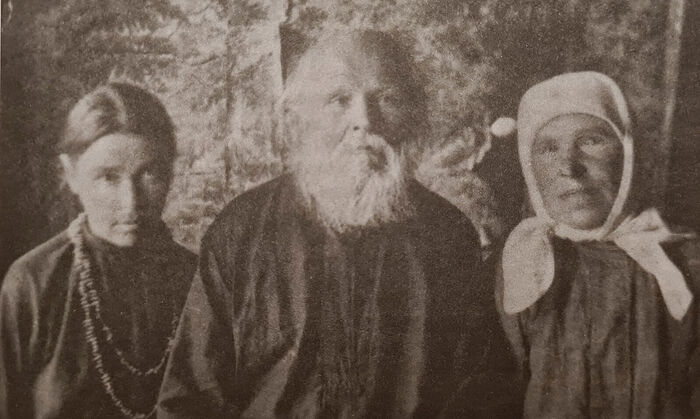 Abbot Ippolit with spiritual daughters Polya and Katya. The 1920s
Abbot Ippolit with spiritual daughters Polya and Katya. The 1920s
Abbot Ippolit was buried at the Nikolskoye Cemetery of what is now Sergiyev Posad, not far from the grave of the holy Elder Barnabas (Merkulov) of the Gethsemane Skete. Over time, the territory of the Nikolskoye Cemetery, which was closed in 1952, began to be built up, and relatives were allowed to rebury the remains of their close ones at the current Northern Cemetery. Elder Ippolit had no relatives, but there were spiritual children who honored his memory.
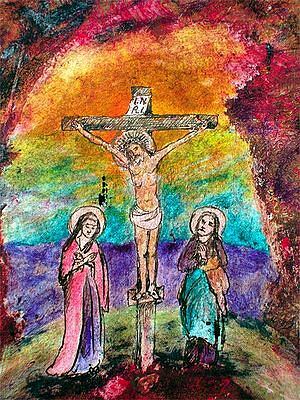 The image of Golgotha on the title page of Abbot Ippolit’ album Among them were Blessed Polya5 and Katya6 who lived in voluntary poverty in the town of Pushkino. Blessed Katya worked for many years as a nurse for free, tending to seriously ill patients. Blessed Polya became immobile after breaking her hip. With the blessing of Elder Ippolit, she did not have an operation. Thus, both ascetics were able to achieve salvation: Polya by patience, and Katya by caring for her neighbor. They lived like this for about twenty years. Having an ardent desire to save the grave of their beloved spiritual father, they asked for help from their assistant Anna Yevseyevna Yushina. On the feast of the Archangel Michael, Anna went to the local authorities to write an application for the reburial of her “father”. All the way there she prayed in fear to St. Nicholas the Wonderworker. Not knowing Abbot Ippolit’s secular name and patronymic, she wrote his name on the application not as Ivan Stepanovich, but as Mikhail Nikolaevich—in honor of the Archangel Michael and St. Nicholas. And a miracle occurred—they found no mistake in the name or in the fact that Anna Yevseyevna wasn’t the elder’s relative. The reburial of the remains was allowed. When Archimandrite Kirill (Pavlov) heard about this, he remarked with surprise: “An ordinary woman came and received permission, but we, all the brethren, can’t get permission to rebury Elder Barnabas of Gethsemane Skete.” But when permission was finally received, on October 17, 1970, the Lavra brethren transferred the remains of Elders Barnabas and Ippolit to the Old (Northern) Cemetery of Sergiyev Posad. Of course, the simultaneous reburial of the relics of two ascetics was not a mere coincidence—we were providentially shown the unity in Christ of two great elders of our time, who were both spiritual fathers, who consoled people in sorrows, and showed us an example for our edification of their holiness and confession of the faith.
The image of Golgotha on the title page of Abbot Ippolit’ album Among them were Blessed Polya5 and Katya6 who lived in voluntary poverty in the town of Pushkino. Blessed Katya worked for many years as a nurse for free, tending to seriously ill patients. Blessed Polya became immobile after breaking her hip. With the blessing of Elder Ippolit, she did not have an operation. Thus, both ascetics were able to achieve salvation: Polya by patience, and Katya by caring for her neighbor. They lived like this for about twenty years. Having an ardent desire to save the grave of their beloved spiritual father, they asked for help from their assistant Anna Yevseyevna Yushina. On the feast of the Archangel Michael, Anna went to the local authorities to write an application for the reburial of her “father”. All the way there she prayed in fear to St. Nicholas the Wonderworker. Not knowing Abbot Ippolit’s secular name and patronymic, she wrote his name on the application not as Ivan Stepanovich, but as Mikhail Nikolaevich—in honor of the Archangel Michael and St. Nicholas. And a miracle occurred—they found no mistake in the name or in the fact that Anna Yevseyevna wasn’t the elder’s relative. The reburial of the remains was allowed. When Archimandrite Kirill (Pavlov) heard about this, he remarked with surprise: “An ordinary woman came and received permission, but we, all the brethren, can’t get permission to rebury Elder Barnabas of Gethsemane Skete.” But when permission was finally received, on October 17, 1970, the Lavra brethren transferred the remains of Elders Barnabas and Ippolit to the Old (Northern) Cemetery of Sergiyev Posad. Of course, the simultaneous reburial of the relics of two ascetics was not a mere coincidence—we were providentially shown the unity in Christ of two great elders of our time, who were both spiritual fathers, who consoled people in sorrows, and showed us an example for our edification of their holiness and confession of the faith.

